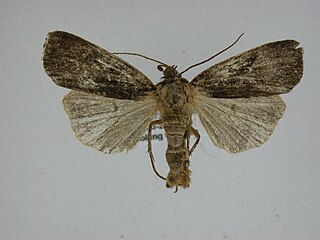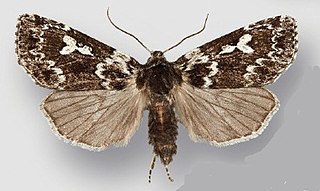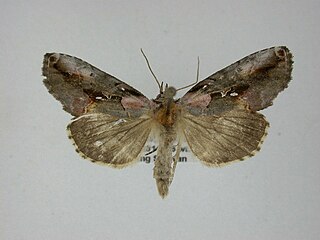
Catocala piatrix, the penitent underwing, is a moth from North America. The species was first described by Augustus Radcliffe Grote in 1864. It is placed in subfamily Catocalinae, either of the family Noctuidae, or – if the Noctuidae are circumscribed more strictly – of family Erebidae. Within the Catocalinae, it belongs to tribe Catocalini and – if the Noctuidae are circumscribed widely – subtribe Catocalina.

Autographa precationis is a moth of the family Noctuidae. It is found in eastern and central North America.

Rachiplusia ou, the gray looper moth, is a moth of the family Noctuidae. The species was first described by Achille Guenée in 1852. It is found in the southern and eastern parts of the United States, Montana, Nova Scotia, from Mexico to Venezuela to Ecuador and the Dominican Republic.

Schinia nuchalis, the spotted sage moth, is a moth of the family Noctuidae. The species was first described by Augustus Radcliffe Grote in 1878. It is found from the Great Plains and Great Basin, from southern Saskatchewan, Alberta and British Columbia south to northern Arizona. The Eurasian Schinia scutosa is no longer considered a synonym of Schinia nuchalis.

Schinia villosa, the little dark gem, is a moth of the family Noctuidae. The species was first described by Augustus Radcliffe Grote in 1864. In North America, it is mostly a western mountain species, however it has also been found across the plains eastward across Alberta and Saskatchewan to southern Manitoba. To the west it is found up to the coast ranges of Washington and British Columbia, south to Arizona.

Enigmogramma basigera, the pink-washed looper, is a moth of the family Noctuidae. The species was first described by Francis Walker in 1865. It is found in the eastern and central United States, south to Mexico. It is also found in the Caribbean, south to French Guiana.

Aseptis fumosa is a moth of the family Noctuidae first described by Augustus Radcliffe Grote in 1879. It is widespread in western North America and is known from western Canada, Washington, Nebraska, Colorado, Utah, Arizona, Nevada and California. It occurs in a variety of diverse habitats including coast chaparral, dry conifer forest, and shrub steppe.
Euxoa campestris, the flat dart, is a moth of the family Noctuidae. The species was first described by Augustus Radcliffe Grote in 1875. It is found in North America from Newfoundland to Alaska, south to New England and southern Canada from southern Quebec west to British Columbia. In the west it is distributed southward in the Rocky Mountains to southern New Mexico, east-central Arizona, and central Utah. In the east it occurs in the Appalachians in eastern Kentucky and in western North Carolina.
Eueretagrotis attentus, the attentive dart or daggered heath dart, is a moth of the family Noctuidae. It is found in North America from Nova Scotia to Saskatchewan and adjacent northern states, south in the Appalachians to Great Smoky Mountains National Park. There is one record from northern Georgia.

Protolampra brunneicollis, the brown-collared dart, is a moth of the family Noctuidae. The species was first described by Augustus Radcliffe Grote in 1864. It is found in eastern North America from New Brunswick to Alberta in southern Canada, and in the United States from Maine to North Carolina and Tennessee west to Mississippi, north to Minnesota, with scattered records in the west from North Dakota, South Dakota and Montana.

Pseudohermonassa bicarnea, the pink-spotted dart, is a moth of the family Noctuidae. The species was first described by Achille Guenée in 1852. It is found in eastern North America, and as far west as south-central Saskatchewan and central North Dakota, south to western North Carolina. It has recently been recorded from Tennessee.

Xestia dilucida, the dull reddish dart or reddish heath dart, is a moth of the family Noctuidae. The species was first described by Herbert Knowles Morrison in 1875. It is found in the United States from southern Maine to northern Florida, west to central Ohio and eastern Texas.
Xestia normaniana, or Norman's dart, is a moth of the family Noctuidae. The species was first described by Augustus Radcliffe Grote in 1874. It is found in North America from Nova Scotia across southern and central Canada to Alberta. In the eastern United States it ranges from Maine to eastern Minnesota, and south along the Appalachians to western North Carolina. It has recently been recorded from Tennessee.

Xestia perquiritata, the boomerang dart, is a moth of the family Noctuidae. The species was first described by Herbert Knowles Morrison in 1874. It is found across North America from Newfoundland, Labrador and northern New England, west to central Yukon, British Columbia and Washington. There are several disjunct populations, including one in the Great Smoky Mountains National Park and the Rocky Mountains in Colorado and a coastal bog in central Oregon.
Abrostola ovalis, the oval abrostola, is a moth of the family Noctuidae. The species was first described by Achille Guenée in 1852. It is found in north-eastern North America from southern Quebec and Maine south to North Carolina and west to Wisconsin.

Allagrapha aerea, the unspotted looper moth or copper looper moth, is a moth of the family Noctuidae. The species was first described by Jacob Hübner in 1803. It is found in eastern North America from southern Ontario to the Florida Panhandle and west to western Nebraska.

Diachrysia balluca, the green-patched looper, is a moth of the family Noctuidae. The species was first described by Carl Geyer in 1832. It is found in north-eastern North America from Nova Scotia west to Manitoba and south to western North Carolina. Great Smoky Mountains National Park is the southern limit of this species. The only other records in the south are from the type locality of Georgia and a record from Liberty County in north-western Florida. These possibly represent strays.
Polychrysia morigera, the disjunct looper, is a moth of the family Noctuidae. The species was first described by Henry Edwards in 1886. In the east of North America, it is found in the Mississippi, Missouri, and Ohio river valleys from Pennsylvania to Tennessee. In the Rocky Mountains it is found from Montana to Colorado and on the west coast it occurs from Oregon to northern California. It is the rarest of the North American Plusiinae species.
Chrysanympha formosa, the Formosa looper, is a moth of the family Noctuidae. The species was first described by Augustus Radcliffe Grote in 1865. It is found in North America from Newfoundland west to Manitoba and south to the mountains of North Carolina and Tennessee.

Eosphoropteryx thyatyroides, the pink-patched looper moth or pink-tinted beauty, is a moth of the family Noctuidae. The species was first described by Achille Guenée in 1852. In North America it is found from Nova Scotia and northern Ontario south to Minnesota, Michigan, Ohio and along the Appalachians from Maine to eastern Tennessee and western North Carolina; and to the west, it occurs from central Alberta and southern British Columbia, south in the Cascades to southern Oregon, and in the Rocky Mountains to northern Idaho.














